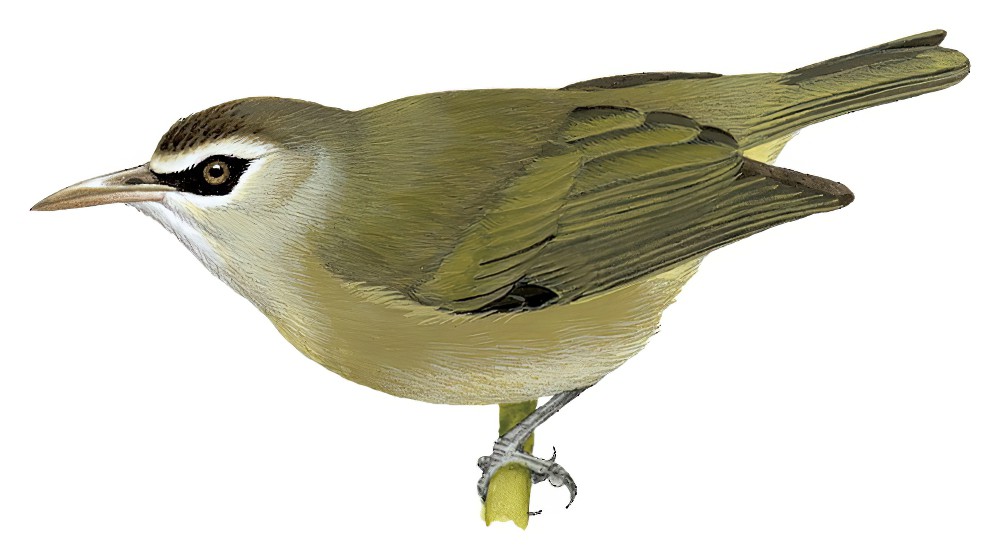Bare-eyed White-eye / Woodfordia superciliosa

Bare-eyed White-eye
SCI Name:
Protonym: Woodfordia superciliosa Vict.Nat. 23 p.104
Taxonomy: Passeriformes / Zosteropidae / Woodfordia
Taxonomy Code: beweye1
Type Locality: Rennell Island.
Author: North
Publish Year: 1906
IUCN Status: Least Concern
DEFINITIONS
Woodfordia
(syn. Zosterops Ϯ Bare-eyed White-eye Z. superciliosus) Charles Morris Woodford (1853-1927) British naturalist, Resident Commissioner in the Solomons Protectorate 1896-1914; "Family—MELIPHAGIDÆ. WOODFORDIA, gen. nov. Bill equal in length to the rest of the head, nearly straight, broader at base, deeper than broad at centre of the apical portion, the culmen distinctly ridged and slightly curved towards the tip. A broad patch in front of the eye and a ring round it bare of feathers, the skin wrinkled, over which is sparingly distributed on that portion in front of the eye very fine, short, white hairs. First primary entirely suppressed, the tip of wing formed by the third, fourth, and fifth primaries. Tail imperfect, some of the central feathers missing; apparently nearly square, and two-thirds the length of the wing. Tarsus comparatively thick, covered with a few scales in front, and nearly one-third longer than bill; feet fleshy, robust. WOODFORDIA SUPERCILIOSA, sp. nov. ... So far as I can discover, it is apparently an entirely new bird. ... Owing to its large bill, short tail, thick tarsus, and stout and fleshy feet, I was doubtful even of the family to which this bird belonged until I had examined its tongue, which is deeply grooved down the centre, bifid, and brush-like at the tip. One, however, of its chief characteristics is the bare ring round, and the wrinkled skin in front of the eye, showing an affinity to the genera Melidectes and Melipotes, but both of these have the skin on the sides of the face smooth, and the bare space larger behind than in the front of the eye. In the total absence of the first primary, Woodfordia resembles the genus Zosterops. I have much pleasure in generically associating with the present species the name of its discoverer, and one who has for many years past, by his well-known work, and collecting of specimens, contributed so largely towards a knowledge of the fauna of the Solomon Islands. Vernacularly the present species may be distinguished as Woodford's Honey-eater." (North 1906); "Woodfordia North, 1906, Victorian Nat., 23, p. 104. Type, by monotypy, Woodfordia superciliosa North." (Mayr in Peters 1967, XII, 319). Some workers decry the use of genetic data to drown morphologically distinct taxa, such as Woodfordia, in more uniform goliath genera.
superciliosa / superciliosum / superciliosus
L. superciliosus supercilious, haughty, eye-browed < supercilium eyebrow.
● ex “Supercilious Duck” of Latham 1785 (Anas).
● ex “Little Green and Orange-coloured Kingfisher” of Edwards 1758 (syn. Chloroceryle aenea).
● ex “Gorge-jaune de Saint-Domingue” of d’Aubenton 1765-1781, pl. 686, fig. 1 (syn. Dendroica dominica).
● ex “Rousseau” of Levaillant 1800, pl. 66 (Lanius).
● ex “Apiaster madagascariensis” or “Guespier de Madagascar” of Brisson 1760 (Merops).
● ex “Yellow-browed Warbler” of Latham 1783 (syn. Phylloscopus humei).
● ex “Supercilious Fly-catcher” of Latham 1783 (unident.).
UPPERCASE: current genus
Uppercase first letter: generic synonym
● and ● See: generic homonyms
lowercase: species and subspecies
●: early names, variants, mispellings
‡: extinct
†: type species
Gr.: ancient Greek
L.: Latin
<: derived from
syn: synonym of
/: separates historical and modern geographic names
ex: based on
TL: type locality
OD: original diagnosis (genus) or original description (species)












